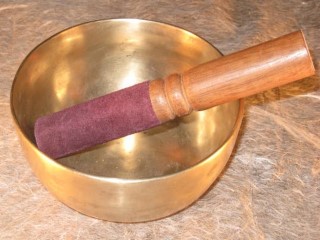Singing bowl frequency is measured in vibrations per second. This measure is commonly known as singing bowl Hertz (Hz). The lower the frequency the slower the vibrations. The musical scale, do re me or A B C can also be expressed in Hz.
A person with excellent hearing can perceive 20 Hz – or 20 vibrations per second. Think of the deepest sound you can imagine. 20 vibrations a second is slow enough you can see it, like on the surface of a bass drum. In music a first octave C, a note you never really hear, is about 32 Hz while a first octave A the lowest key on a piano is 27.5 Hz. Singing bowls are never that deep, below 70 Hz is extremely rare.
Theoretically people can hear 20,000 Hz (20 KHz) but as far as I know that is limited to children and people living in societies without amplified sound. Most audiologists are happy if you can hear 12 KHz but they will test you higher if it looks like you have something left up there.
It is common in the singing bowl world to assign a frequency to a bowl. Unfortunately, it is not as simple as even that for the sound can vary based on the strike. Tapping high or low on the side wall, thicker or thinner spots can produce subtle differences that both the software and your ear can pick up. If your strike is on the side away from the microphone you will get a slightly different singing bowl frequency than hitting it on the same side. A warm room can get a bit different reading than a cold environment. We label Hz as “approximate”, not because of equipment limitations – we run the best software available – but because we do not have sufficient confidence in the absolute stability of this metric for any singing bowl.
How to Check and Measure Singing Bowl Frequency
Measuring singing bowl frequency digitally is an interplay between hardware, the microphone, and software, the sound processing engine. Microphones are not all alike and you can get different readings running the same software with different mics. Not a big difference, generally, but enough to take a bit of an edge off the illusion of exactness.
On the software side, the program needs to isolate sound bowl frequencies and then process them individually. Lots of phone apps have problems with this and jump from note to note. There is software out there designed for composers that has very good frequency isolation. Once the software isolates the frequency, that is tracks each individual note and overtone, the next step is to generate a number of data points for each tone. By data points I mean individual readings over time, sometimes hundreds of readings per second. When you examine a data dump on a bowl what you don’t see is the same frequency over and over. Instead, the readings spread over a range. This range might be narrow, under 1 Hz or wide 5 Hz and even more. The software will take an average or the most frequent occurrence (mode) and display that as the Tibetan singing bowl’s frequency.
In 2012 I collaborated with the late Dr. Carolyn Bremer of the Bob Cole Conservatory of Music at Cal State, Long Beach to develop a program to track the individual frequencies in singing bowls. Carolyn was a great fan of singing bowls (and had a few of ours). I worked with her students to develop the basic frame work and then employed software engineers to complete the process. The basic software we used for the project is Max by Cycling ’74. Max is rather specialized and not out-of-the-box user friendly but it does have the ability to employ multiple sound processing engines to generate frequency readings. Our programming was aimed at following frequencies through amplitude decay. In addition to this program we also use third party software to analyze sound clips and generate a frequency report. We get pretty good agreement among the various programs, but not perfect, again adding nuance to the concept of exactness.
Amplitude
Amplitude is the strength of a sound wave. It is measured objectively in decibels (dB – named after the father of the telephone). Loudness is our perception of that amplitude. You’d think the stronger the amplitude, the louder the sound – but our minds do not work that way. Evolution has optimized our hearing for the sound of language. Powerful but deep sounds seem soft while much less powerful sounds in higher frequencies seem very loud. A woman speaking in English uses frequencies from 200 Hz (the sound of J or M) to 5,000 Hz (the sound of S or th). A very deep male voice might go as low as 100 Hz. The human brain is wired to accentuate the sounds in the speech range. It is no coincidence that the frequencies of singing bowls are close the range of our language driven perceptual sweet spot.
















